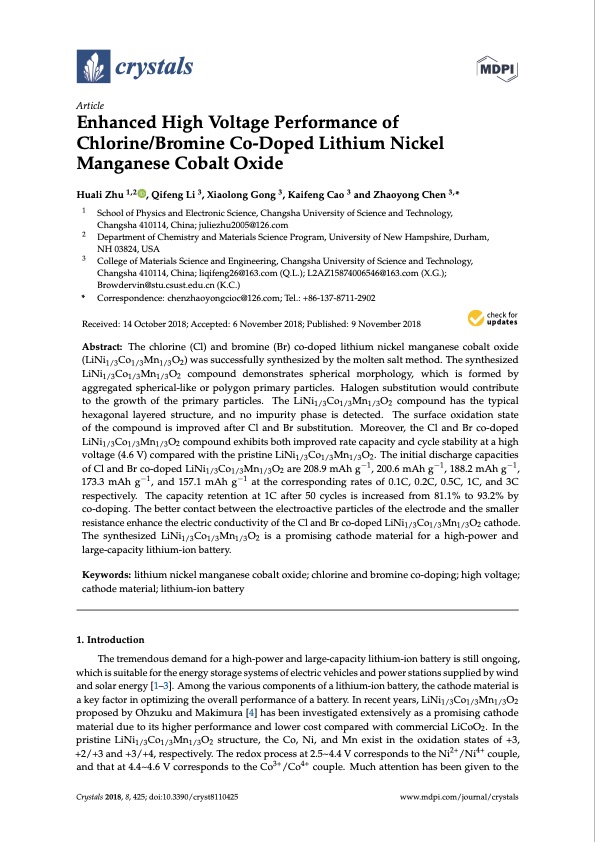
PDF Publication Title:
Text from PDF Page: 001
crystals Article Enhanced High Voltage Performance of Chlorine/Bromine Co-Doped Lithium Nickel Manganese Cobalt Oxide Huali Zhu 1,2 , Qifeng Li 3, Xiaolong Gong 3, Kaifeng Cao 3 and Zhaoyong Chen 3,* 1 2 3 * Correspondence: chenzhaoyongcioc@126.com; Tel.: +86-137-8711-2902 Received: 14 October 2018; Accepted: 6 November 2018; Published: 9 November 2018 School of Physics and Electronic Science, Changsha University of Science and Technology, Changsha 410114, China; juliezhu2005@126.com Department of Chemistry and Materials Science Program, University of New Hampshire, Durham, NH 03824, USA College of Materials Science and Engineering, Changsha University of Science and Technology, Changsha 410114, China; liqifeng26@163.com (Q.L.); L2AZ15874006546@163.com (X.G.); Browdervin@stu.csust.edu.cn (K.C.) Abstract: The chlorine (Cl) and bromine (Br) co-doped lithium nickel manganese cobalt oxide (LiNi1/3Co1/3Mn1/3O2) was successfully synthesized by the molten salt method. The synthesized LiNi1/3 Co1/3 Mn1/3 O2 compound demonstrates spherical morphology, which is formed by aggregated spherical-like or polygon primary particles. Halogen substitution would contribute to the growth of the primary particles. The LiNi1/3 Co1/3 Mn1/3 O2 compound has the typical hexagonal layered structure, and no impurity phase is detected. The surface oxidation state of the compound is improved after Cl and Br substitution. Moreover, the Cl and Br co-doped LiNi1/3Co1/3Mn1/3O2 compound exhibits both improved rate capacity and cycle stability at a high voltage (4.6 V) compared with the pristine LiNi1/3Co1/3Mn1/3O2. The initial discharge capacities of Cl and Br co-doped LiNi1/3Co1/3Mn1/3O2 are 208.9 mAh g−1, 200.6 mAh g−1, 188.2 mAh g−1, 173.3 mAh g−1, and 157.1 mAh g−1 at the corresponding rates of 0.1C, 0.2C, 0.5C, 1C, and 3C respectively. The capacity retention at 1C after 50 cycles is increased from 81.1% to 93.2% by co-doping. The better contact between the electroactive particles of the electrode and the smaller resistance enhance the electric conductivity of the Cl and Br co-doped LiNi1/3Co1/3Mn1/3O2 cathode. The synthesized LiNi1/3Co1/3Mn1/3O2 is a promising cathode material for a high-power and large-capacity lithium-ion battery. Keywords: lithium nickel manganese cobalt oxide; chlorine and bromine co-doping; high voltage; cathode material; lithium-ion battery 1. Introduction The tremendous demand for a high-power and large-capacity lithium-ion battery is still ongoing, which is suitable for the energy storage systems of electric vehicles and power stations supplied by wind and solar energy [1–3]. Among the various components of a lithium-ion battery, the cathode material is a key factor in optimizing the overall performance of a battery. In recent years, LiNi1/3Co1/3Mn1/3O2 proposed by Ohzuku and Makimura [4] has been investigated extensively as a promising cathode material due to its higher performance and lower cost compared with commercial LiCoO2. In the pristine LiNi1/3Co1/3Mn1/3O2 structure, the Co, Ni, and Mn exist in the oxidation states of +3, +2/+3 and +3/+4, respectively. The redox process at 2.5~4.4 V corresponds to the Ni2+/Ni4+ couple, and that at 4.4~4.6 V corresponds to the Co3+/Co4+ couple. Much attention has been given to the Crystals 2018, 8, 425; doi:10.3390/cryst8110425 www.mdpi.com/journal/crystalsPDF Image | Enhanced High Voltage Performance of Chlorine Bromine

PDF Search Title:
Enhanced High Voltage Performance of Chlorine BromineOriginal File Name Searched:
crystals-08-00425.pdfDIY PDF Search: Google It | Yahoo | Bing
Product and Development Focus for Salgenx
Redox Flow Battery Technology: With the advent of the new USA tax credits for producing and selling batteries ($35/kW) we are focussing on a simple flow battery using shipping containers as the modular electrolyte storage units with tax credits up to $140,000 per system. Our main focus is on the salt battery. This battery can be used for both thermal and electrical storage applications. We call it the Cogeneration Battery or Cogen Battery. One project is converting salt (brine) based water conditioners to simultaneously produce power. In addition, there are many opportunities to extract Lithium from brine (salt lakes, groundwater, and producer water).Salt water or brine are huge sources for lithium. Most of the worlds lithium is acquired from a brine source. It's even in seawater in a low concentration. Brine is also a byproduct of huge powerplants, which can now use that as an electrolyte and a huge flow battery (which allows storage at the source).We welcome any business and equipment inquiries, as well as licensing our flow battery manufacturing.| CONTACT TEL: 608-238-6001 Email: greg@salgenx.com | RSS | AMP |